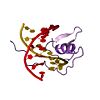Michael Pikaart/Biochem StructureIntro
From Proteopedia
(New page: 100px Chem311 Course Page 1 - Introduction to protein structure) |
|||
| Line 1: | Line 1: | ||
| - | [[Image:Gata_dna.jpg|100px]] Chem311 Course Page 1 | + | [[Image:Gata_dna.jpg|100px]] <big>Chem311 Course Page 1 Introduction to protein structure</big> |
| + | |||
| + | |||
| + | == Introduction == | ||
| + | A protein's function depends on the proper folding of the linear polymeric chain of amino acids making up its polypeptide sequence. Folding of a polypeptide occurs by way of rotation of the single bonds in either side of each amino acid residue's alpha carbon, characterized by the Φ and Ψ angles. In folded proteins, stretches of amino acids typically have a re-iterated and restricted set of Φ and Ψ angles, giving rise to a length of stable secondary structure. If this structure has a rotational displacement, the result is a helical secondary structure; if the structure occurs in a zig-zag arrangement, a sheet secondary structure results. Here we will explore these two types of secondary structures, as found in actual proteins. | ||
| + | |||
| + | == Alpha helix == | ||
| + | Helix or screw structures are found in lots of contexts, both in nature and in man-made objects. | ||
Revision as of 15:24, 23 August 2010
 Chem311 Course Page 1 Introduction to protein structure
Chem311 Course Page 1 Introduction to protein structure
Introduction
A protein's function depends on the proper folding of the linear polymeric chain of amino acids making up its polypeptide sequence. Folding of a polypeptide occurs by way of rotation of the single bonds in either side of each amino acid residue's alpha carbon, characterized by the Φ and Ψ angles. In folded proteins, stretches of amino acids typically have a re-iterated and restricted set of Φ and Ψ angles, giving rise to a length of stable secondary structure. If this structure has a rotational displacement, the result is a helical secondary structure; if the structure occurs in a zig-zag arrangement, a sheet secondary structure results. Here we will explore these two types of secondary structures, as found in actual proteins.
Alpha helix
Helix or screw structures are found in lots of contexts, both in nature and in man-made objects.
